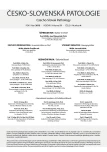-
Medical journals
- Career
The autopsy of the brain and spinal cord in the diagnosis of neurodegenerative diseases - a practical approach to optimize the examination
Authors: Zdeněk Rohan; Radoslav Matěj
Authors‘ workplace: Centrum pro výzkum, diagnostiku a léčbu neurodegenerativních onemocnění a Národní referenční laboratoř TSE-CJN, Thomayerova nemocnice, Praha ; Oddělení patologie a molekulární medicíny
Published in: Čes.-slov. Patol., 51, 2015, No. 4, p. 199-204
Category: Reviews Article
K tomuto textu naleznete obrazové eSupplementum na www.CSpatologie.cz
Overview
Brain and spinal cord autopsies aimed at neuropathological diagnosis of the causes of dementia and motor abnormalities are of increasing importance. Neuropathological brain examination is often the only diagnostic modality capable of definitive diagnosis of a neurodegenerative disease and thus serves as invaluable feedback for clinicians and biochemical and imaging diagnostics. The brain and spinal cord autopsy is performed following a standardized protocol and its goal is to sample all diagnostically relevant structures. Subsequent diagnostics are then done using standard and special histologic stainings, however state-of-the-art diagnostics can be achieved only using immunohistochemical methods. The purpose of the article is to provide the pathologists with a brief and practical guideline for brain and spinal cord autopsy when diagnosis of a neurodegenerative disease is suspected.
Keywords:
dementia - neurodegenerative diseases - brain autopsy
Sources
1. Kovacs GG, Botond G, Budka H. Protein coding of neurodegenerative dementias: the neuropathological basis of biomarker diagnostics. Acta Neuropathol 2010; 119(4): 389-408.
2. Kovacs GG, Milenkovic I, Wohrer A, Hoftberger R, Gelpi E, Haberler C, et al. Non-Alzheimer neurodegenerative pathologies and their combinations are more frequent than commonly believed in the elderly brain: a community-based autopsy series. Acta Neuropathol 2013; 126(3): 365-384.
3. Janocko NJ, Brodersen KA, Soto-Ortolaza AI, Ross OA, Liesinger AM, Duara R, et al. Neuropathologically defined subtypes of Alzheimer’s disease differ significantly from neurofibrillary tangle-predominant dementia. Acta Neuropathol 2012; 124(5): 681-692.
4. Toledo JB, Brettschneider J, Grossman M, Arnold SE, Hu WT, Xie SX, et al. CSF biomarkers cutoffs: the importance of coincident neuropathological diseases. Acta Neuropathol 2012; 124(1): 23-35.
5. Murray ME, Graff-Radford NR, Ross OA, Petersen RC, Duara R, Dickson DW. Neuropathologically defined subtypes of Alzheimer’s disease with distinct clinical characteristics: a retrospective study. Lancet Neurol 2011; 10(9): 785-796.
6. Kovacs GG, Budka H. Current concepts of neuropathological diagnostics in practice: neurodegenerative diseases. Clin Neuropathol 2010; 29(5): 271-288.
7. Rohan Z, Matěj R. Current concepts in the classification and diagnosis of frontotemporal lobar degenerations: a practical approach. Arch Pathol Lab Med 2014; 138(1): 132-138.
8. Love S. Autopsy approach to stroke. Histopathology 2011; 58(3): 333-351.
9. Love S. Post mortem sampling of the brain and other tissues in neurodegenerative disease. Histopathology 2004; 44(4): 309-317.
10. Matěj R, Rusina R. Neurodegenerativní onemocnění: Přehled současné klasifikace a diagnostických neuropatologických kritérií. Cesk Patol 2012; 48(2): 83-90.
11. Mori K, Weng SM, Arzberger T, May S, Rentzsch K, Kremmer E, et al. The C9orf72 GGGGCC repeat is translated into aggregating dipeptide-repeat proteins in FTLD/ALS. Science 2013; 339(6125): 1335-1338.
Labels
Anatomical pathology Forensic medical examiner Toxicology
Article was published inCzecho-Slovak Pathology

2015 Issue 4-
All articles in this issue
- The autopsy of the brain and spinal cord in the diagnosis of neurodegenerative diseases - a practical approach to optimize the examination
- Morphology of surgical complications in liver biopsies early after transplantation
- Diagnosis of rejection in a transplanted liver
- Recurrence of primary diseases after liver transplantation
- Transplantations of lungs in the Czech Republic – from the perspective of the pathologist
- Surgical techniques of organ transplants
- Periosteal osteosarcoma - personal experience with five cases
- Renal allograft biopsies: a guide of ins and outs for best results
- Czecho-Slovak Pathology
- Journal archive
- Current issue
- Online only
- About the journal
Most read in this issue- Periosteal osteosarcoma - personal experience with five cases
- Transplantations of lungs in the Czech Republic – from the perspective of the pathologist
- Diagnosis of rejection in a transplanted liver
- Surgical techniques of organ transplants
Login#ADS_BOTTOM_SCRIPTS#Forgotten passwordEnter the email address that you registered with. We will send you instructions on how to set a new password.
- Career

